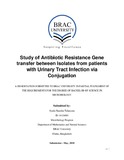Browsing by Subject "Gene"
Now showing items 1-6 of 6
-
Determination of transfer of Azithromycin resistance gene though Conjugation, among Enterobacteriaceae, isolated from Urinary Tract Infected patients
(BRAC Univeristy, 2018-05)Urinary Tract Infections (UTI) are a predominant bacterial infection caused by pathogens that are resistant to a long list of antibiotics and the greater challenge nowadays is to stop the spread of resistance to them. This ... -
An investigation of Mobilized Colistin-Resistance (MCR) gene and underlying dissemination mechanism using clinical, poultry and environmental samples in Bangladesh
(Brac University, 2020-01)Colistin, widely considered as the last-resort antibiotic for the treatment against multidrug-resistant (MDR) gram-negative bacteria worldwide, is being used indiscriminately in the poultry, livestock and fishery farms ... -
A review on Cytogenetic Biomarkers in Autism Spectrum Disorder and Probable Protective Function of Vitamin E
(Brac University, 2020-12)Autism spectrum disorder (ASD) is a neurodevelopmental disorder with impaired sociability, disabled verbal and nonverbal interaction and repetitive or restrictive stereotypical behaviors. According to some assessments, ... -
A review on Single Nucleotide Polymorphism (SNPs) and their effect on cancer risk in South Asian population
(Brac University, 2021-01)Cancer is one of the leading causes of death and currently 1 in 6 death is known to occur due to cancer. Each type of cancer is linked to variations occurring in the gene. Any form of genetic variation which disrupts the ... -
Study of antibiotic resistance gene transfer between isolates from patients with urinary tract infection via conjugation
(BRAC Univeristy, 2018-05)The Urinary Tract Infection is caused recurrently by Escherichia coli and also by Proteus spp., Klebsiella spp., Enterococcus spp., Staphylococcus spp. etc. [3, 11] Recently, UTIs are considered a severe public health ... -
A study of glioblastoma gene profile
(BRAC University, 2020-01)Glioblastoma is one of the most common and deadliest forms of brain cancer. The cell growth rate of glioblastoma is highly proliferated and they travel into other cells. Glioblastoma multiform introduced in 1926 by ...






